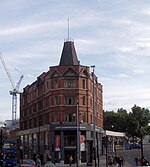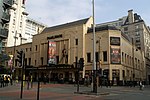Little Ireland
1827 establishments in England19th century in ManchesterCotton industry in EnglandEthnic enclaves in the United KingdomHistory of Greater Manchester ... and 4 more
History of ManchesterIrish diaspora in EnglandSlums in EuropeTextile mills in Manchester

Little Ireland was a slum district of Manchester, England in the early 19th century. It was inhabited from about 1827 to 1847 by poor Irish immigrants, and during its existence gained a reputation as the archetypal Irish district in nineteenth century industrial cities. Despite this reputation, the slum was the shortest lived of all the areas of Irish settlement in the city, and also the smallest, covering about four acres. The area existed south of Oxford Road railway station, enclosed by the railway line and the loop in the River Medlock.
Excerpt from the Wikipedia article Little Ireland (License: CC BY-SA 3.0, Authors, Images).Little Ireland
Great Marlborough Street, Manchester City Centre
Geographical coordinates (GPS) Address Nearby Places Show on map
Geographical coordinates (GPS)
| Latitude | Longitude |
|---|---|
| N 53.473055555556 ° | E -2.2419444444444 ° |
Address
Great Marlborough Street 8
M1 5NN Manchester, City Centre
England, United Kingdom
Open on Google Maps










